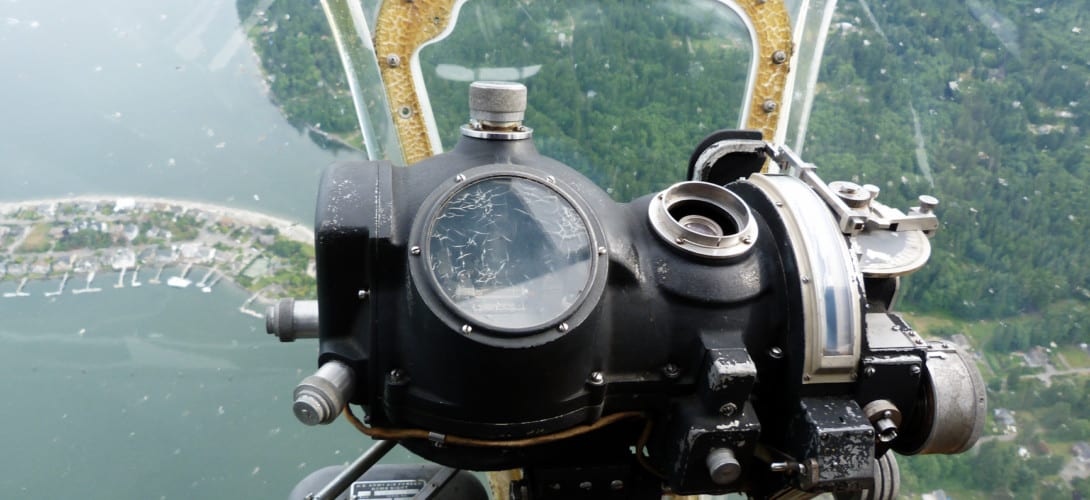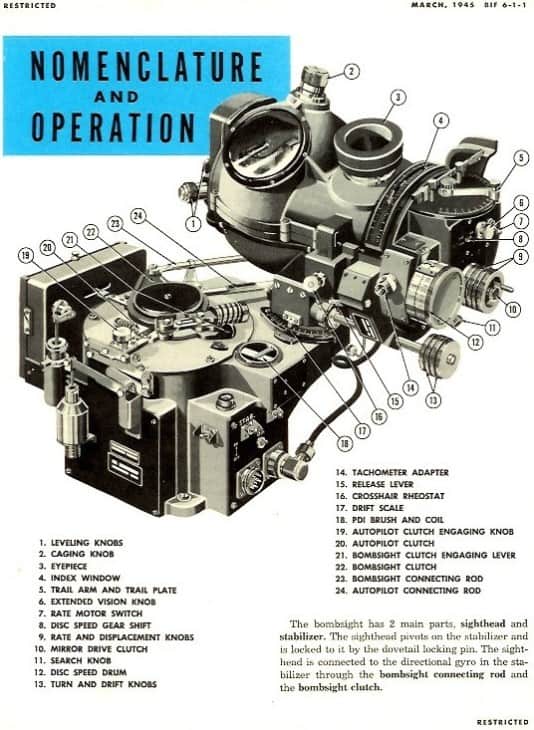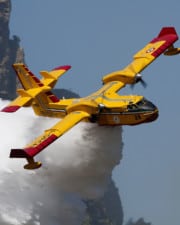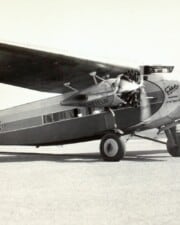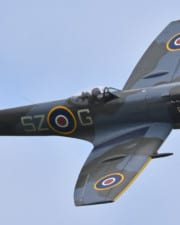Before the computer-aided, laser-guided smart bombs of today, quick-thinking and well-trained bombardiers had to use math to calculate their bomb drops. At the dawn of aviation, it was easy enough in slow-moving fabric-on-frame biplanes. But when the fast-moving high-altitude bombers of World War II came along, the challenge required new technology.
Bombsights were devices that combined tools that the bombardier needed to hit their targets successfully. The most famous example from the Second World War was the Norden bombsight, designed by Carl Norden in 1931 and sold to the US Navy and the US Army Air Corps.
The Norden bombsight was standard equipment in the iconic Allied bombers of WWII — the B-17 and B-25 both had Norden units onboard. There were so accurate and so reliable that the military used them into the Vietnam War when “smart” weapons replaced the need for manual sighting and aiming.
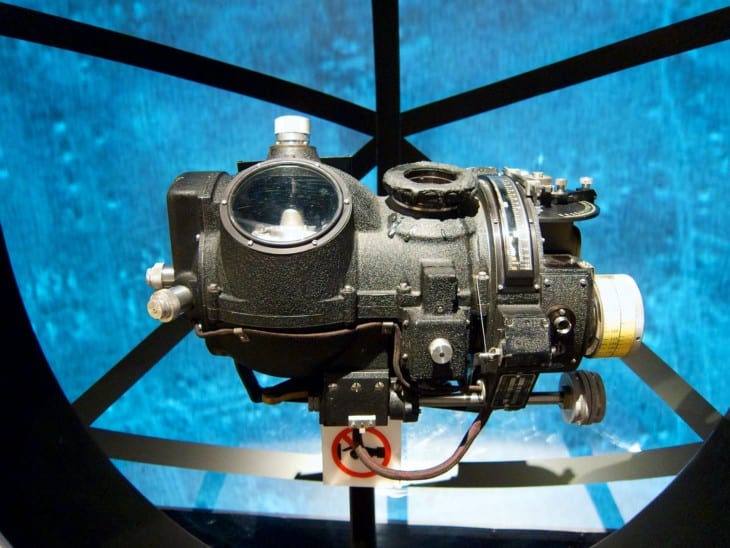
What is a Bombsight?
Dropping things out of airplanes is easy. The hard part comes when you want the object you’re dropping to hit a specific thing on the ground.
There are a lot of factors at play. The speed of the airplane. The altitude of the airplane. The speed and direction of the wind. The weight and size of the object.
When the first aerial bombers took to the air in World War I, the bombardiers didn’t have much to work with. It was a learning process of trial and error.
A bombsight was a tool designed to help the bombardier hit their intended target. The earliest examples weren’t much more complex than a spotting scope with marked increments to help the pilot line up.
As planes flew faster, high, and carried greater payloads, a system had to be devised for getting the bombs to land on target. Bombsights became highly complex devices that blended precision optical scopes mounted on stabilized gimbals. They even connected with the plane’s autopilot system.

History of the Bombsight
Once released from the aircraft, the path that bombs take to their target is affected by gravity and the drag of the air passing over it. A wide range of factors, from the air density to the wind at altitude, can affect a bomb’s trajectory.
You can minimize these factors by dropping the bombs at low altitudes, but this technique puts the bomber aircraft in danger from ground forces. High-altitude bombing is nearly always preferred, but it requires careful calculations that have to be done quickly and accurately.
During World War I, bombsights were simple. They were often iron sights that were pre-set an estimated fall angle. Sometimes they were nothing more than notches or lines drawn on a spar.
These early systems couldn’t be very accurate, especially with speed and altitude changes. More advanced systems were made that allowed the pilot to adjust an iron sight to set in their airspeeds and altitude. Then a simple vector calculator was added to add in the wind component. The result was a simple device that would be accurate for bomb drops from about 3,000 feet and up to about 150 knots.
It’s also important to realize that targeted bombing campaigns play an important part in a war effort’s success. Much of the early use of bomber aircraft was used to mass destruction, and accuracy wasn’t so important. By dropping many bombs, you’re likely to take out your target. Unfortunately, you’re also likely to cause a lot of collateral damage.
The World War II Allied war efforts put a premium on bombing runs that destroyed strategic targets. Airfields, bridges, or oil-supply facilities are examples of high-value targets. These are things that hampered the enemy’s ability to wage war. It’s this tactic that is widely credited as having turned the tide of the war in Europe.
But for the tactic to work, a method of bomb targeting had to be devised. Today, advanced radar and laser-guided bomb systems produce excellent accuracy results that were science-fiction-like at the beginning of WWII. Before developing the micro-computer and these other technologies, mechanical apparatuses had to be devised to get the job done.
Vector Bombsights
There was a significant boom in aviation technologies after the First World War. Aircraft began flying much higher and faster, and the bombing payloads were significantly increased. Mechanical computers were being used to help pilots solve complicated and complex problems quickly and accurately.
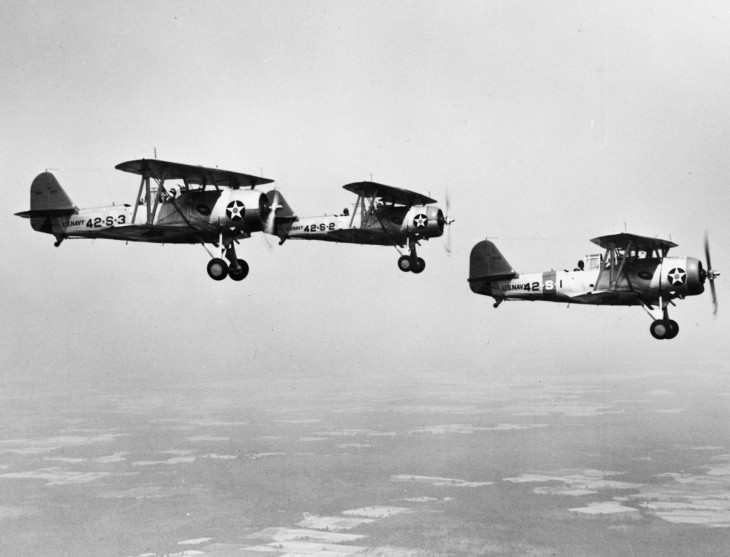
The most successful bomb sight design integrated a vector calculator system and was called the CSBS, or Course Setting Bomb Sight. To use the CSBS, the bombardier would dial in the aircraft’s altitude and airspeed. Then, to correct for wind drift, the bomber would watch objects on the ground pass through the sight. By giving signals to the pilot, the plane’s course could be altered to correct all wind effects.
As dependable as the CSBS was, it has some significant shortcomings. If the intended target was moving, it was nearly impossible for the pilot and bombardier to correct the wind drift. So they weren’t very accurate when used against ships.
The CSBS design came out in 1917 and was used throughout the Second World War by many services. The British used it until 1942. It was gradually improved upon over those years.
The most significant factor in the CSBS’s demise was how large bombing aircraft had grown. The CSBS required careful coordination between the pilot and bomber. In the new larger aircraft, the two positions were often far apart in the plane.
Vector bombsights required a long, straight approach before dropping the bombs. It required time for the bombardier to calculate the necessary factors and get the sight set up correctly.
Using a vector bombsight required skill, patience, and attention to detail. The angles could be dialed in, but the math had to be done manually. To make it go faster, bombardiers had equation tables handy to solve the angles as quickly and accurately as possible.
Other Bombsight Advances
One small advancement helped the communication problem, though. Pilot direction indicators were designed. This was a simple instrument attached to the bombsight that directed the pilot which way they should steer. Much like other navigation systems, the pilot only had to follow an electrical pointer on an instrument rather than follow the bomber’s hand signals.
Another problem bombardiers had with bombsights came from the performance of the new bomber aircraft. They were maneuverable and responsive, but all of that made getting a clear sight through a spotting scope difficult.
By mounting the bombsight on a gimbal, the unit could hold steady as the aircraft maneuvered. That allowed the bombardier to continue sighting no matter what happened. Early studies in the 1920s found that a gyroscope could double the accuracy of the bombsight.
Tachometric Bombsights
Norden was one of the first companies to combine a mechanical computer’s qualities into the actual bombsight. These computers used wheels and dials to solve complex math problems. By setting a few known factors, in this case, airspeed, altitude, and wind drift, the computer could do all of the math for the bombardier. This type of tool was called a tachometric bombsight.
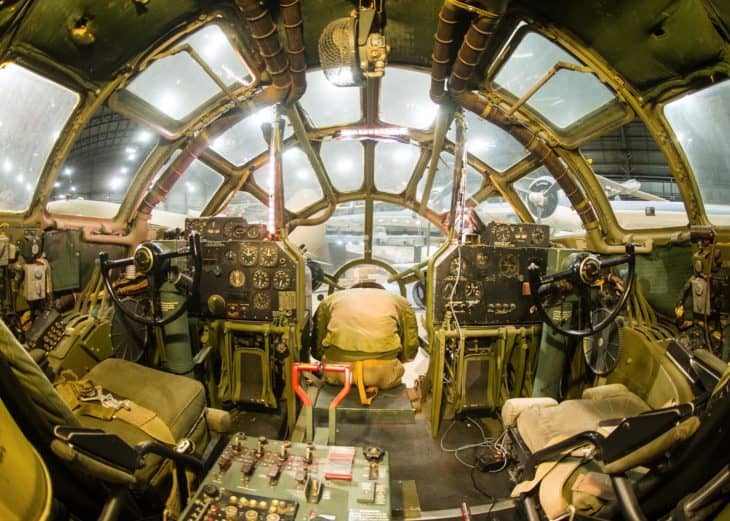
To make things even easier, more advanced bombsights were tied into the aircraft systems. The instruments already knew a lot of the data needed, so there was no reason for the bombardier to plug it manually. It could take airspeed and altitude directly from the pilot’s gauges.
Connections like these saved time, but they also reduced errors and improved the accuracy of the equipment.
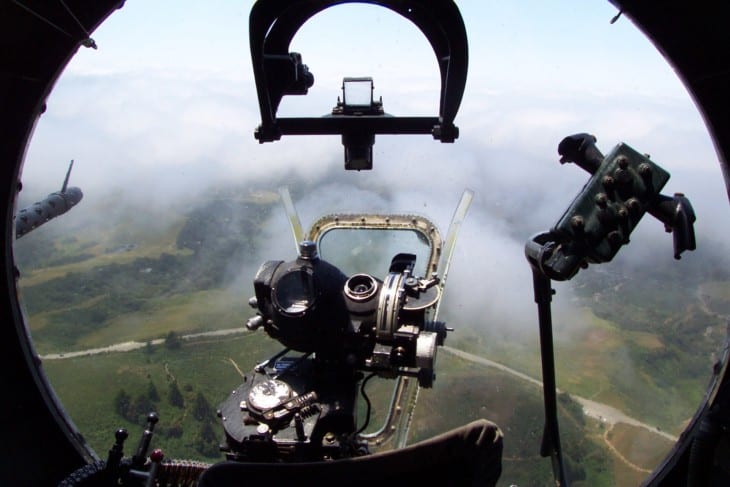
All of these little pieces of the puzzle were around and used during the 1920s, but only the US Army Air Corps and the US Navy were putting money into research and development a system that brought them all together. The Navy funded the Norden bombsight, while the Army backed a similar project by Sperry Gyroscopes.
In the end, the Norden proved to be the most accurate of the two. Eventually, the Sperry units’ features were integrated into later versions of the Norden.
Norden bombsights also included another state-of-the-art feature — they had a rudimentary autopilot built in. The aircraft’s drift due to wind still had to be corrected for, but it was discovered to be much more accurate to let the bombardier control it through the bombsight’s telescope.
The pilot could set the rough heading that he wanted the aircraft to hold. Then, the telescope controls were fed directly into the aircraft’s automatic flight controls, in effect allowing the bombardier to control the flight path. The effect was much more accurate, with a quicker response time than the human pilot would be able to accomplish.
What Makes a Norden Bombsight Special?
The Norden bombsight is remembered by history thanks to a little bit of luck and timing.

Like many famous innovations, the Norden bombsight didn’t invent an entirely new technology. What it did was take a bunch of parts and put them together into one tool that solved a practical problem. The technology was there. The only revolutionary thing was putting it all together and using it in a new way.
About the Norden Bombsight Inventor
Carl Norden was a Dutch engineer who emigrated to the US in 1904. He worked for the Navy on various projects, including working on improving their Course Setting Bomb Sights. His first designs were simple improvements, like combining the bombardiers sighting with the scope with the pilot’s direction indicator instruments.
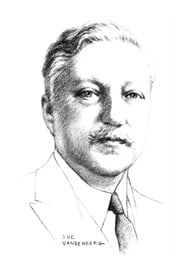
But the government wanted a fully automatic system that was easier to use and more accurate than the old CSBS. Norden got the contract to build what became known as the Mark XV in 1929. He worked tirelessly to develop all of the bits and pieces and delivered the finished product in 1931.
Norden Bombsight Production
The Carl L. Norden Company incorporated that year and began producing bombsights for the Navy, and later for the Army Air Corps as well. The Air Corps referred to the unit as the M-1.
Norden bombsights eventually became the standard piece of equipment for the high-altitude bombers of World War II. Most famously, the B-17 Flying Fortresses were outfitted with reliable and accurate Norden bombsights.
A Norden bombsight was used to drop the nuclear bombs “Fat Man” and “Little Boy” on Hiroshima and Nagasaki in 1945. That bombsight, and the Enola Gay B-29 Superfortress that dropped the bombs, is on display at the National Air and Space Museum in Washington, DC.
Modern Bomb Aiming
The Korean and Vietnam conflicts saw the last use of conventional visual bombsights such as the Norden. For high-speed jet aircraft, a conventional bombsight with a spotting scope is nearly useless. When you’re dropping a bomb and going at 1,000 miles per hour, you can’t even see what you want to hit with enough advanced notice.
Radar-based systems eventually replaced traditional bombsights, but even these had their drawbacks. They were widely used during the Cold War for nuclear armaments because the accuracy needed with a nuclear weapon isn’t that great.
Modern bombs are called “smart bombs” because the weapons themselves have guidance systems. Instead of relying solely on gravity to do the job, these bombs have guidance systems that can home in on a target as they fall. Bombs can be laser-guided to guided by GPS.
To control the bomb’s built-in systems, pilots usually have controls integrated right into their primary heads-up displays.
Lore and History of the Norden Bombsight
Carl Norden’s project was surrounded by deep secrecy. Norden was contracted to work for the Navy, and even the Army only had the faintest idea of what was being worked on when he started. The public didn’t get a glimpse of the now-famous apparatus until 1943. Workers who built the bombsights at factories around the US were sworn to secrecy.

Despite the efforts to keep the bombsight under wraps, details leaked out. Designs had been passed to the Germans before WWII even started, and with them, they built their own very similar device. The Lotfernrohr 7 worked well for them, pushing out many earlier bombsights and emerging as the primary unit used by the Luftwaffe towards the end of the war.
Debates still rage as to whether or not the Norden bombsight was “revolutionary” or not. Did it change the outcome of the war? Was it any better than its only other competitor, the Sperry system?
Regardless of where you stand on the issue, the Norden bombsight can be credited with simplifying bombing operations and improving overall effectiveness. The system had its problems, but it did work very well under the most grueling conditions.
References ▾
Related Posts
